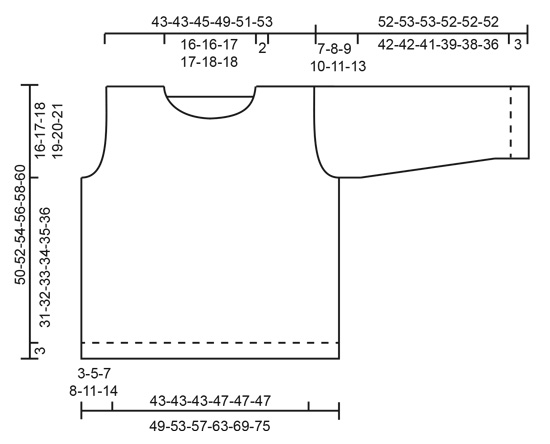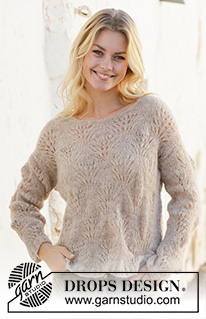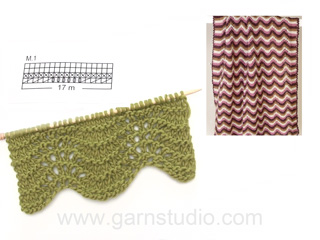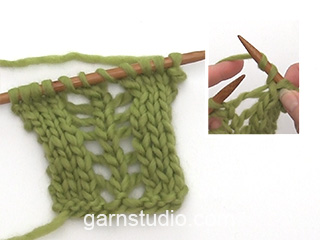Footprints in the Sand |
||||||||||
 |
 |
|||||||||
Knitted sweater with wave pattern in DROPS Brushed Alpaca Silk. Sizes S - XXXL.
DROPS 202-3 |
||||||||||
|
------------------------------------------------------- EXPLANATIONS FOR THE PATTERN: ------------------------------------------------------- RIDGE/GARTER STITCH (worked back and forth): Knit all rows. 1 ridge in height = Knit 2 rows. RIDGE/GARTER STITCH (worked in the round): 1 ridge in height = 2 rounds, i.e. knit 1 round and purl 1 round. PATTERN: See diagrams A.1 to A.3. Choose diagram for your size. The diagrams show all the rows in the pattern seen from the right side. DECREASE TIP (evenly spaced): To work out how to decrease evenly, count the total number of stitches on the needle (e.g.124 stitches) minus edge stitches (= 2 stitches) and divide the remaining stitches by number of decreases to be made (e.g. 36) = 3.38. In this example, decrease by alternately knitting together each 2nd and 3rd stitch and each 3rd and 4th stitch. INCREASE TIP (for sleeves): Increase 1 stitch by making 1 yarn over inside the 1 edge stitch on each side. On the next row work the yarn overs twisted to avoid holes. ------------------------------------------------------- START THE PIECE HERE: ------------------------------------------------------- SWEATER - SHORT OVERVIEW OF THE PIECE: The piece is worked back and forth with circular needle, bottom up and sewn together to finish. BACK PIECE: Cast on 124-132-140-156-172-180 stitches (including 1 edge stitch on each side) with circular needle size 4 mm = US 6 and Brushed Alpaca Silk. Purl 1 row from the wrong side, then work rib from the right side as follows: 1 edge stitch in GARTER STITCH – read description above, (knit 2, purl 2) until there are 3 stitches left, knit 2 and 1 edge stitch in garter stitch. Continue this rib back and forth for 3 cm = 1⅛" – adjust so that the next row is worked from the right side. Knit 1 row with 1 edge stitch in garter stitch on each side where you decrease 36-38-40-44-50-50 stitches evenly spaced – read DECREASE TIP = 88-94-100-112-122-130 stitches. Work 1 row stockinette stitch back from the wrong side with 1 edge stitch in garter stitch on each side. Change to circular needle size 5.5 mm = US 9. Now work pattern – choose diagram for your size, as follows: 1 edge stitch in garter stitch, stockinette stitch over the next 5-8-11-13-18-22 stitches, A.1 over the next 9-9-9-10-10-10 stitches, A.2 over the next 57-57-57-63-63-63 stitches (= 3 repeats in width), A.3 over the next 10-10-10-11-11-11 stitches, 5-8-11-13-18-22 stitches in stockinette stitch and 1 edge stitch in garter stitch. Continue back and forth like this until the diagrams have been completed in height. REMEMBER THE KNITTING GAUGE! Now work pattern – choose diagram for your size, as follows: 1 edge stitch in garter stitch, 5-8-11-13-18-22 stitches in stockinette stitch, A.2 over the next 76-76-76-84-84-84 stitches (= 4 repeats in width), 5-8-11-13-18-22 stitches in stockinette stitch and 1 edge stitch in garter stitch. When the diagram has been completed in height, continue this pattern, i.e. work first A.1, A.2 and A.3 as described at the beginning of the piece and then 4 repeats of A.2 in width so that the wave pattern is displaced each time it is worked in height. The remaining stitches are worked in stockinette stitch and 1 edge stitch in garter stitch on each side. When the piece measures 34-35-36-37-38-39 cm = 13⅜"-13¾"-14¼"-14½"-15"-15¼" from the cast-on edge (measure from where the rib at the beginning of the piece slopes downwards/is longest) bind off for armholes in each side as follows: Bind off 4 stitches 1-1-1-1-2-2 times, 2 stitches 0-1-1-2-2-3 times and 1 stitch 1-2-3-3-3-4 times (= 5-8-9-11-15-18 stitches bind off on each side) = 78-78-82-90-92-94 stitches. When the armhole measures approx. 13-14-15-16-17-18 cm = 5⅛"-5½"-6"-6¼"-6¾"-7" from where the binding off began (there is approx. 3 cm = 1⅛" left to finished length) bind off the middle 26-26-28-28-30-30 stitches from the right side at the same time as the 2 first and 2 last of these 26-26-28-28-30-30 stitches are knitted together before casting off (= 24-24-26-26-28-28 stitches for neck) = 26-26-27-31-31-32 stitches for shoulder on each side. Continue with as many whole repeats as there is room for in width and the remaining stitches are worked in stockinette stitch with 1 edge stitch in garter stitch on each side. AT THE SAME TIME on the next row from the neck bind off 1 stitch = 25-25-26-30-30-31 stitches for shoulder. When the armhole measures 16-17-18-19-20-21 cm = 6¼"-6¾"-7"-7½"-8"-8¼" work stockinette stitch with 1 edge stitch in garter stitch on each side where you decrease 2-2-3-3-3-2 stitches evenly on row = 23-23-23-27-27-29 stitches. Bind off. Make sure that the bind-off edge is not tight. Work the other shoulder in the same way. The piece measures a total of 50-52-54-56-58-60 cm = 19¾"-20½"-21¼"-22"-22¾"-23⅝" from the shoulder down. FRONT PIECE: Cast on, work pattern and bind off for the armhole in the same way as for the back piece = 78-78-82-90-92-94 stitches. When the piece measures 41-43-44-46-47-49 cm = 16⅛"-17"-17¼"-18"-18½"-19¼" from the cast-on edge work the next row from the right side as follows: Work pattern as before over the first 31-31-33-37-37-38 stitches, knit the next 16-16-16-16-18-18 stitches and at the same time decrease 2 stitches evenly (= 14-14-14-14-16-16 stitches) and place these stitches 14-14-14-14-16-16 on a thread for the neck, work pattern as before over the remaining 31-31-33-37-37-38 stitches. Then work each shoulder separately. Continue with as many repeats of the pattern in width as there is room for and the remaining stitches are worked in stockinette stitch with 1 edge stitch in garter stitch on each side. AT THE SAME TIME bind off stitches for the neck on each row as follows: Bind off 3 stitches 1 time, 2 stitches 1 time and 1 stitch 1-1-2-2-2-2 times = 25-25-26-30-30-31 stitches on shoulder. When the armhole measures 16-17-18-19-20-21 cm = 6¼"-6¾"-7"-7½"-8"-8¼" work stockinette stitch with 1 edge stitch in garter stitch on each side where you decrease 2-2-3-3-3-2 stitches evenly on row = 23-23-23-27-27-29 stitches. Bind off. Make sure that the bind-off edge is not tight. Work the other shoulder in the same way. The piece measures a total of 50-52-54-56-58-60 cm = 19¾"-20½"-21¼"-22"-22¾"-23⅝" from the shoulder down. SLEEVES: The sleeves are worked back and forth with circular needle, bottom up. Cast on 54-54-58-62-66-66 stitches with circular needle size 4 mm = US 6 and Brushed Alpaca Silk. Purl 1 row from the wrong side and then work rib from the right side as follows: 1 edge stitch in garter stitch, (knit 2, purl 2) until there is 1 stitch left on row and 1 edge stitch in garter stitch. Continue this rib back and forth for 3 cm = 1⅛" – adjust so that the next row is worked from the right side. Knit 1 row with 1 edge stitch in garter stitch on each side where you decrease 12-10-12-14-16-16 stitches evenly spaced = 42-44-46-48-50-50 stitches. Work 1 row stockinette stitch back from the wrong side with 1 edge stitch in garter stitch on each side. Change to circular needle size 5.5 mm = US 9. READ THIS WHOLE SECTION BEFORE CONTINUING. Work pattern – choose diagram for your size, as follows: 1 edge stitch in garter stitch, 1-2-3-2-3-3 stitches in stockinette stitch, A.1 over the next 9-9-9-10-10-10 stitches, A.2 over the next 19-19-19-21-21-21 stitches, A.3 over the next 10-10-10-11-11-11 stitches, 1-2-3-2-3-3 stitches stockinette stitch and 1 edge stitch in garter stitch. When A.1 to A.3 have been completed in height, work 2 repeats of A.2 in width – choose diagram for your size, over the 38-38-38-42-42-42 stitches in the pattern. When the 2 repeats of A.2 have been completed in height, work A.1, A.2 and A.3 as before over the 38-38-38-42-42-42 stitches with pattern. Continue this pattern upwards, i.e. work alternately in height first A.1, A.2 and A.3 and then A.2 (2 repeats in width). AT THE SAME TIME when the piece measures 9-8-7-7-6-6 cm = 3½"-3⅛"-2¾"-2¾"-2⅜"-2⅜" increase 1 stitch on each side of the piece – read INCREASE TIP (for sleeves). Increase as follows in the different sizes: Size S: Increase every 8 cm = 3⅛" a total of 5 times. Size M: Increase alternately every 5 cm = 2" and 6 cm = 2⅜" a total of 7 times. Size L: Increase alternately every 5 cm = 2" and 6 cm = 2⅜" a total of 7 times. Size XL: Increase alternately every 4 cm = 1½" and 5 cm = 2" a total of 8 times. Size XXL Increase every 4 cm = 1½" a total of 9 times. Size XXXL: Increase every 3 cm = 1⅛" a total of 11 times. When all the increases are finished there are 52-58-60-64-68-72 stitches on the needle. The new stitches are worked in stockinette stitch. When the piece measures 45-45-44-42-41-39 cm = 17¾"-17¾"-17¼"-16½"-16⅛"-15¼" (shorter measurements in larger sizes due to wider yoke) continue the pattern as before and bind off stitches for the sleeve cap on the beginning of each row on each side as follows: Bind off 4 stitches 1 time, 2 stitches 2 times, 1 stitch 0-2-2-2-2-4 times, 2 stitches 2-2-4-5-6-5 times and 4 stitches 2-2-1-1-1-1 time = 12-14-16-16-16-20 stitches left. Bind off the remaining stitches. The sleeve measures approx. 52-53-53-52-52-52 cm = 20½"- 21"-21"-20½"-20½"-20½". Work the other sleeve in the same way. ASSEMBLY: Sew shoulder seams with grafting stitches. Sew sleeves to body inside the 1edge stitch in garter stitch on body and inside the bind-off edge on sleeves. Make sure that the seam is not tight! Sew sleeve and side seams in one go. Repeat on the other side. NECK: Start mid top of shoulder and knit up 74-74-82-82-88-88 stitches with Brushed Alpaca Silk and circular needle size 4 mm = US 6. Work 2 ridges and bind off. |
||||||||||
Diagram explanations |
||||||||||
|
||||||||||

|
||||||||||

|
||||||||||
|
Have you made this or any other of our designs? Tag your pictures in social media with #dropsdesign so we can see them! Do you need help with this pattern?You'll find tutorial videos, a Comments/Questions area and more by visiting the pattern on garnstudio.com. © 1982-2024 DROPS Design A/S. We reserve all rights. This document, including all its sub-sections, has copyrights. Read more about what you can do with our patterns at the bottom of each pattern on our site. |
||||||||||
































































Comments / Questions (54)
Kan dere lage denne oppskriften som rundstrikk?
24.02.2024 - 14:23DROPS Design answered:
Hej Merete, vi kan ikke skrive opskriften om ;) ....men det kan du selv gøre, sørg for at rapporten i din størrelse går op i maskeantallet (de 3 mindste størrelser har 19 masker i en rapport) :)
01.03.2024 - 14:13I made this jumper and followed the pattern and measurements to the letter. The final result was very disappointing, the body was too short whilst the width was too large. I used the right wool and needles. It is not tje first time that your patterns do not correspond to the size indicated.
08.02.2024 - 18:06Buongiorno, vorrei creare un cardigan con questo modello come posso fare?
27.01.2023 - 13:47DROPS Design answered:
Buonasera Loredana, purtroppo in questa sede non possiamo adattare i modelli alle singole esigenze: per un'assistenza così personalizzata può rivolgersi al suo rivenditore DROPS di fiducia. Buon lavoro!
28.01.2023 - 23:04When doing the twice yarn over as the symbol is on the line does this mean that you knit a stitch before the yarn overs and finish with a knit stitch at the end of the yarn overs. The symbol is on the line and this is confusing. Any help would be appreciated.
05.09.2022 - 19:50DROPS Design answered:
Dear Mrs White, work diagrams in size S,M,L for example work: (double YO, K1, double YO, K1, double YO, K1, k2 tog, k2 tog, K2 tog) - A.2 = (K2 tog, K2 tog, K2 tog, K1, double YO, K1, double YO,K1, double YO,K1, double YO,K1, double YO,K1, double YO, K1, K2 tog, K2 tog, K2 tog) repeat from (to), A.3=K2 tog, K2 tog, K2 tog, K1, double YO, K1, double YO, K1, double YO, K1, Happy knitting!
06.09.2022 - 09:20Kan det passe at der skal bruges så lidt garn fleks 5 nøgler af 25 gr til str. s
05.04.2022 - 22:08DROPS Design answered:
Hej Henriette, ja det stemmer, husk det er et hulmønster :)
08.04.2022 - 08:35Bonjour, J'aimerai tricoter ce pull en rond, donc en supprimant les mailles lisières au pt mousse, cela ne va t'il pas poser problème pour le motif fantaisie lors des diminutions pour les emmanchures ? Même question en ce qui concernes les manches Merci
04.02.2022 - 22:02DROPS Design answered:
Bonjour Sab, vous pourrez probablement adapter le point fantaisie pour le tricoter en rond, puis, lors des emmanchures, vous rabattrez 2 mailles en moins de chaque côté la 1ère fois (= pas de mailles lisières). Pareil pour les manches, rabattez 2 m en moins . Bon tricot!
07.02.2022 - 08:41Bonjour , j'aimerai savoir la taille du modéle qui est en photos pour me donner une idée . Merci d'avance et bonne journée à vous
22.11.2021 - 05:52DROPS Design answered:
Bonjour Mme Jolivot, le modèle porte probablement soit une taille S soit une taille M, mais pour choisir votre taille, mesurez un pull similaire dont vous aimez la forme et comparez ces mesures à celles du schéma. Retrouvez plus d'infos sur les tailles ici. Bon tricot!
22.11.2021 - 08:47Jeg er i tvivl, om jeg skal strikke en str. L eller XL. Hvordan finder jeg brystvidden i opskriftens størrelser??
18.10.2021 - 15:33DROPS Design answered:
Hej Pia, du finder målene i måleskitsen nederst i opskriften, her finder du også en video som viser hvordan man bruger måleskitsen :)
21.10.2021 - 09:08Je ne comprends pas en quoi consiste de tricoter 4 motifs de A2 en largeur après avoir tricoté A1 A2 et A3. Doit on faire simplement les 3 diagrammes une seule fois? Que signifie les 4 motifs de A2 en largeur?
20.07.2021 - 16:15DROPS Design answered:
Bonjour Florence, vous devez tricoter A.1, A.2, A3 et ensuite 4 x A.2. Regardez la lecon DROPS ICI, a voir 'Plusieurs diagrammes tricotés consécutivement sur le rang/tour'. Bon tricot!
20.07.2021 - 21:10Hej. Er det muligt at strikke denne opskrift rundt på rundpind, istedet for at strikke for- og bagstykke hver for sig?
12.04.2021 - 08:51DROPS Design answered:
Hej Laura, ja det kan du gøre :)
12.04.2021 - 13:33